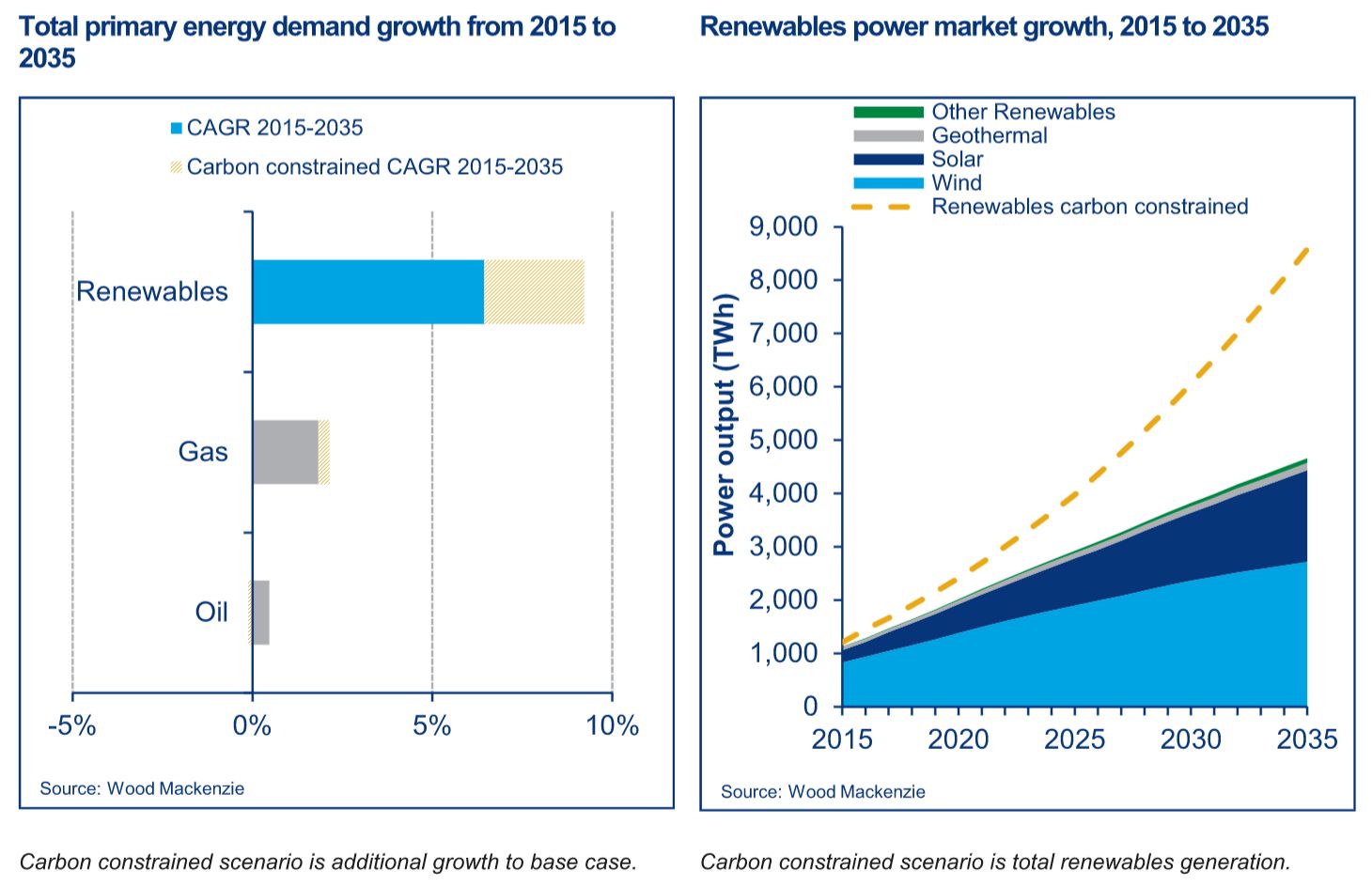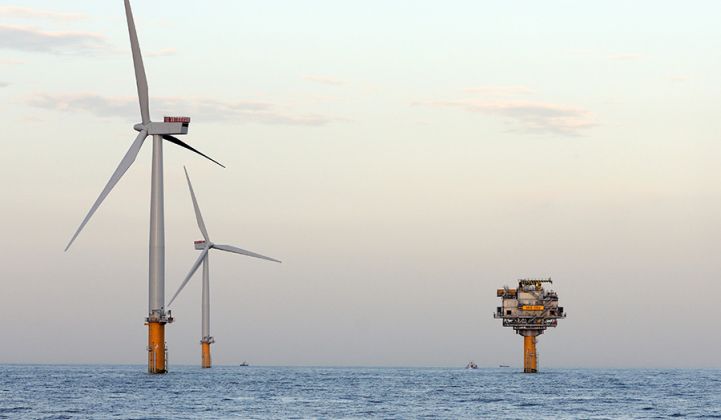Wind and solar have reached a point where they’re impossible for the world’s largest oil and gas companies to ignore. But it’s not yet clear how the majors will choose to capitalize on this growing market, having wavered on clean energy in the past.
A new report from Wood Mackenzie examines the threat that renewable energy poses to legacy oil and gas operations, as well as the opportunity for wind and solar to diversify and future-proof fossil-fuel-heavy portfolios.
The global market for wind and solar is currently just 4 percent that of oil and gas; however, renewables are set to grow “much faster than oil demand,” the report states. By 2035, annual revenues from wind and solar will represent one-twelfth of the revenues in oil and gas under Wood Mackenzie’s base-case scenario. In a carbon-constrained scenario -- which assumes negative growth for coal and oil demand, and positive growth for natural gas and other zero-carbon fuels out to 2035 -- revenues from wind and solar would be much higher.
“The majors are faced with a mega trend of cost reductions and continuous growth in renewables that started slow but is gaining momentum,” said Valentina Kretschmar, director of corporate research at Wood Mackenzie and co-author of the report. “It’s driven by technology innovation that seems absolutely unstoppable right now, and there is a realization among the majors that it’s a trend that’s not going away -- and that it’s a threat to their core business.”
Renewables will satisfy only 1 percent of the world’s energy needs this year, but even in Wood Mackenzie’s base-case scenario, renewables will be the fastest-growing primary energy source worldwide over the next 20 years. The research firm projects average annual growth rates of 6 percent for wind and 11 percent for solar. By 2035, wind and solar will have captured 8 percent and 5 percent of the global power supply, respectively. The total primary energy demand for oil, meanwhile, is forecast to grow just 0.5 percent per year.
In a future with even tighter environmental regulations, Wood Mackenzie projects solar and wind will make up a 23 percent combined share of the global power market by 2035, and 6 percent of the total market for all forms of energy. In this carbon-constrained scenario -- which assumes strong adoption of electric vehicles and highly efficient gas-powered engines, in addition to renewables -- oil demand peaks before 2030 and “subsequently enters a slow decline, putting prices under pressure,” the report states.
For a sense of scale, Wood Mackenzie projects overall revenues from renewables in 2035 will be nearly three times greater than those from U.S. unconventionals -- the industry’s No. 1 growth segment -- under the carbon-constrained scenario. That's a market worth getting into.

Source: Wood Mackenzie, "Could renewables be the majors’ next big thing?"
Not the first renewables rodeo, so what's different?
This isn’t the first time big oil companies have considered the business risks and benefits of renewable energy. Over the past few decades, the majors have made meaningful investments in wind, solar and other clean energy resources. But more recently, they backed off.
British Petroleum made its first solar investment in 1981. Then in 2001, BP rebranded itself as “Beyond Petroleum” and changed its logo to a green and yellow sunburst to signify the company’s embrace of renewable energy. But the new slogan didn’t stick. BP quietly retired the renewables campaign and sold off its solar assets in 2011, following the Deepwater Horizon oil spill. Two years later, BP divested its U.S. wind farm division to focus on high-yield oil and gas projects.
Chevron acquired its renewable energy arm in 2000, and went on to develop multiple large-scale solar and geothermal projects. The division was successful. Chevron Energy Solutions doubled its projected profit target in 2013, Bloomberg reports. But because these revenues were so small in the context of Chevron’s total earnings, management decided to officially nix the renewables arm in August 2014. Chevron said the sale was part of a “strategic focus on supporting Chevron’s upstream and downstream businesses.”
A few months prior to that, Chevron sold its 48-person business unit that developed renewable power plants and energy efficiency projects for U.S. federal agencies. The oil giant also cut funding for biofuel projects in 2013.
Royal Dutch Shell suspended its investments in wind, solar and hydrogen projects in 2009. "They continue to struggle to compete with the other investment opportunities we have in our portfolio," Linda Cook, head of Shell's gas and power unit, said of solar and wind at the time.
But times have changed.
Four years after pulling out of the renewable energy space, Shell released a report that found solar PV could become the leading energy source by the end of the century. As a 110-year-old company, it’s not unreasonable for Shell to look at projections several decades in the future. In 2016, Shell and Saudi Aramco joined forces to launch a renewable energy investment fund. Other oil majors are also reconsidering their wind and solar strategies.
“Things are different now,” said Kretschmar. “What’s different is the momentum; there’s momentum behind the technology, and we’ve seen renewable energy costs drop dramatically in the last five years. Also, we didn’t have the same mental pressure 10 years ago.”
In 2015, global leaders banded together at the United Nations climate talks in Paris, with nearly 200 countries agreeing to set national policies to reduce their carbon emissions. President Trump’s announcement earlier this month that the U.S. will withdraw from the Paris Agreement seems to have only galvanized support for climate action in other countries and at other levels of government. In addition to new policies, oil companies are facing pressure to diversify from environmental groups and even some investors. No one wants to be like Kodak when the digital camera came to market.
“I think the majors have to keep their…finger on the pulse of this fast-growing trend,” Kretschmar said. “Talking about [a transition in] 2030 might be too late. They may have to act sooner, because they could risk erosion of their value and balance sheets that enable them to get into a new space.”
A balance between core business and new opportunities
European firms Statoil and Total have arguably been the most proactive on the renewables front among the oil majors. Statoil has made significant investments in offshore wind in Europe -- leveraging its experience in offshore oil drilling -- and will soon expand to the U.S. Total, meanwhile, has positioned itself to be a global leader in solar and batteries.
The European companies have tended to be more active in the clean energy space, according Kretschmar. That’s likely because these firms are facing greater governmental pressure, and because U.S. firms are benefiting from low-cost unconventional oil and gas production, and don’t feel the same sense of urgency to invest in new businesses.
There is a limit to how much it currently makes sense for the oil majors to invest in wind and solar, according to Wood Mackenzie. In order to replicate the 12 percent market share the majors hold in oil and gas, researchers estimate the majors would need to spend $350 billion on solar and wind out to 2035 -- or around a quarter of the $1.5 trillion Wood Mackenzie estimates the majors need to spend to sustain upstream volumes to 2035. In this bullish (and admittedly unlikely) scenario, renewables would increase to just 6.5 percent of the majors’ fossil fuel production on an energy-equivalent basis in 20 years' time.
This represents “a disproportionate investment that would have to go into renewables,” said Kretschmar. “But there is also an understanding that the cost of renewable energy is coming down, and there are other means of getting into renewables as well.” For instance, building a renewables business through M&A could be a more economically effective way of gaining market share in this new space.
The value proposition for wind and solar is also competitive today when compared to some less attractive upstream oil and gas investments. Furthermore, these companies can benefit from the long lives and stable cash flows of clean energy projects that help to support shareholder dividends.
Despite the evidence that wind and solar will be increasingly important to strategic growth, the majors and their investors are still coming to grips with the value proposition and the timing of the transition. “This presents difficult capital allocation choices in the near term,” the report states. “The majors will need to strike a balance between sustaining their core oil and gas business while keeping their options open in alternative energy.”
The report goes on to note, however, that early movers might be at a competitive advantage in accessing new opportunities.
“Players that are slower to embrace new energy will rely much more on low-cost oil and gas supply to drive future performance,” according to Wood Mackenzie analysts. “They could find themselves at a structural disadvantage if there is rapid penetration of renewables into the energy mix and entry costs rise.”



